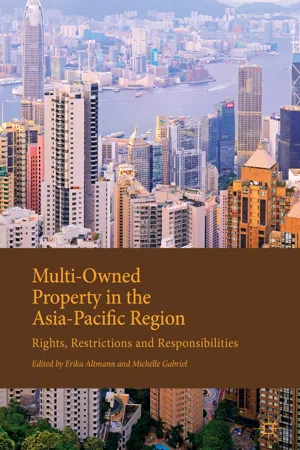An Introduction to Multi-owned Property
The densification of Asia-Pacific cities has been underpinned by substantial growth in multi-owned property (MOP) development, which in turn is associated with the emergence of complex urban governance structures. While escalating investor and owner demand for properties within the central precincts of Asia-Pacific global cities has created an exuberance around the benefits of apartment living and investment , less well understood are the substantial constraints on individual rights, restrictions and responsibilities (3Rs) associated with collective living. From a range of geographic and disciplinary perspectives, our contributors question the assumptions that support today’s compact city hype. This collection canvases structural issues, including established and emerging legislative and policy settings, as well as illuminating the experience of strata managers, owners, residents and their agency within these processes. Here we unpack the rights, restrictions and responsibilities (3Rs) of MOP ownership across the Asia-Pacific region.
At a global level, population growth and urban migration have facilitated the growth of mega cities, growth in investment housing across international borders, and the growth of new industries that support property management activities. Views of housing and the ontology of home are no longer intertwined as the former becomes a tradable commodity in which renters have a very different set of rights, responsibilities and restrictions compared to landlords or owner-occupiers . To cater for the changing demographic market , short-term furnished lets are increasing and attract higher rates of renta l return to offset increasingly high purchase prices in many countries . The ontological security that home previously provided (Rose 1995) may become harder to establish with apartment building complexes as a result of the growth in interested parties, decreasing privacy and additional layers of governance . The rights, restrictions and responsibilities of each party may become more difficult to establish under such circumstances.
This work fills a gap in the existing literature by bringing together new, contemporary research on MOP . Unlike existing books in this area which take an international approach, we focus solely on the Asia-Pacific experience. We believe that the Asia-Pacific region has a different and valuable story to add to what is known about the European and North American MOP experience. The primary value of this collection is that it will bring together contrasting case examples of historical and cultural ways of living. In contrast to the highly populated and traditional communal housing arrangements seen in China , Hong Kong , Taiwan , Singapore , Malaysia and India , Australia approaches apartment living from an individualistic view. It is an approach which is increasingly noted and explored throughout this collection as we probe Eastern perspectives.
We begin with a short discussion on the antecedents of MOP, providing definitions that are central to each chapter and this edition. The second part of the chapter outlines the structure of the edition and provides a brief synopsis of how each chapter builds upon each other. In our final chapter we revisit our central idea—to highlight similarities and differences across law , management and the lived experience across the Asia-Pacific region with a view to identifying common themes and building a basis for future action, whether changes to law, policy or education.
Here to There, Then to Now
There has been significant discussion as to where and how current models of strata titled property ownership developed. McKenzie (1996) traces the strata title mechanism back to a corrupted version of Ebenezer Howard’s Garden City in Nebraska, USA. Howard first developed his view of a garden city at the turn of twentieth century, where work , home and recreation are co-mingled and easily accessible to all tenants . In his view, tenants were also key stakeholders in the community . They lived and worked there, but also owned the community and therefore had rights and responsibilities within that community , including a say in how it was run. Howard’s utopian view did not dwell on restrictions that went with his ideal community , nor was it the first time that similar models of living had been proposed. Indeed, it is possible that Howard developed his model on nineteenth century Parisian property models, although Bagaeen and Uduku’s (2011) work on gated communities suggests that similar forms of shared living are much older and more prevalent on a worldwide basis.
Before proceeding further, an outline of the strata title mechanism is required. Both Everton-Moore et al. (2006) and Johnston and Reid (2013) provide comparative anal...
